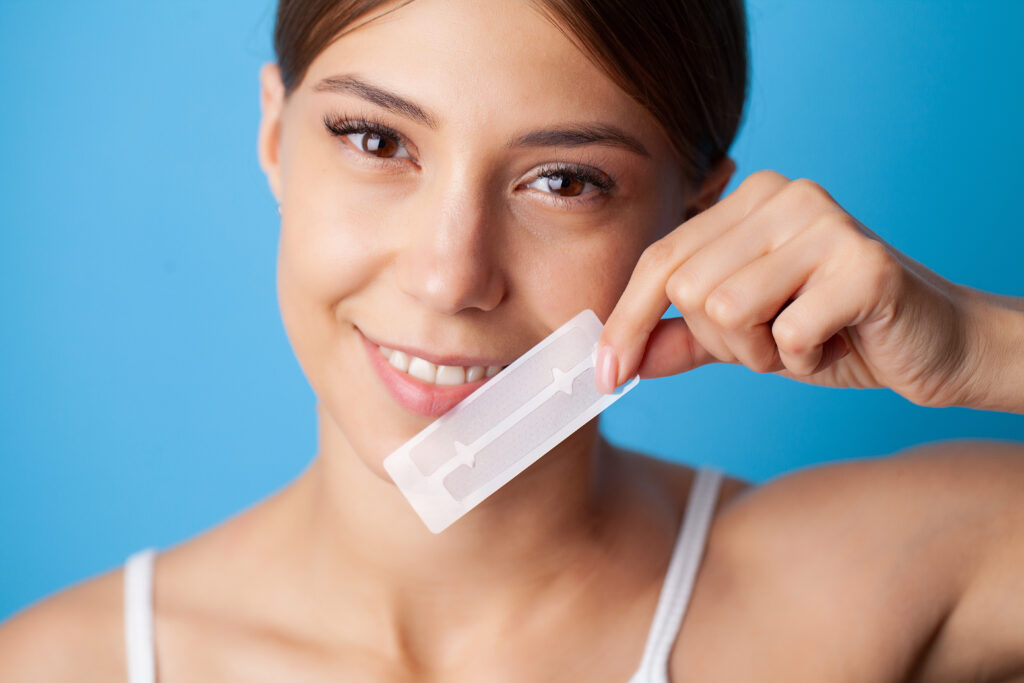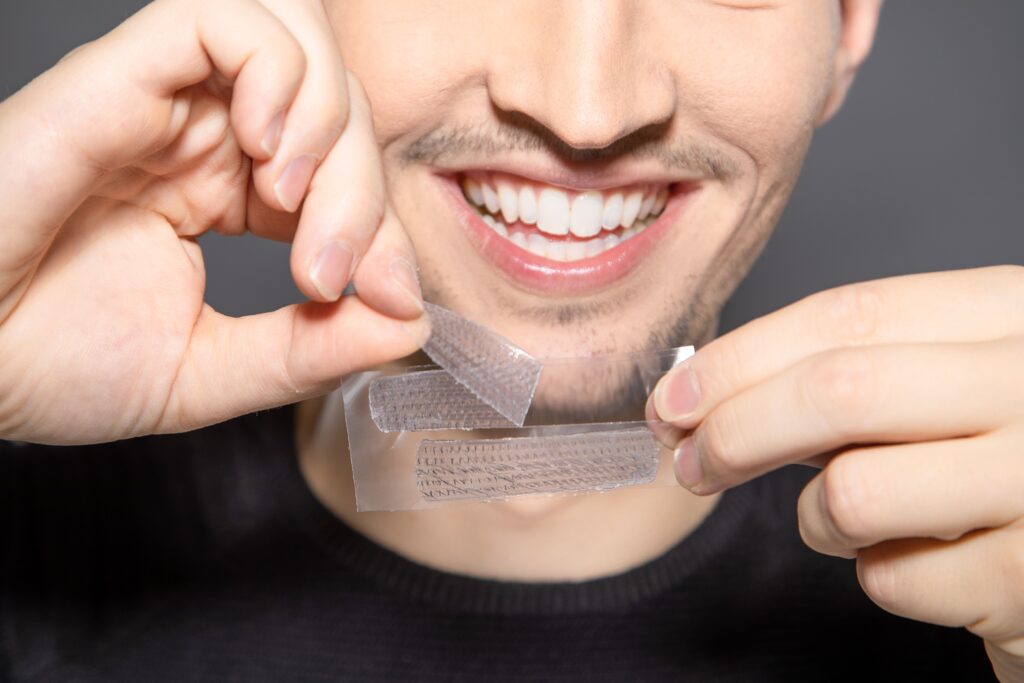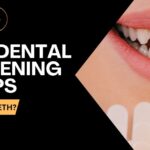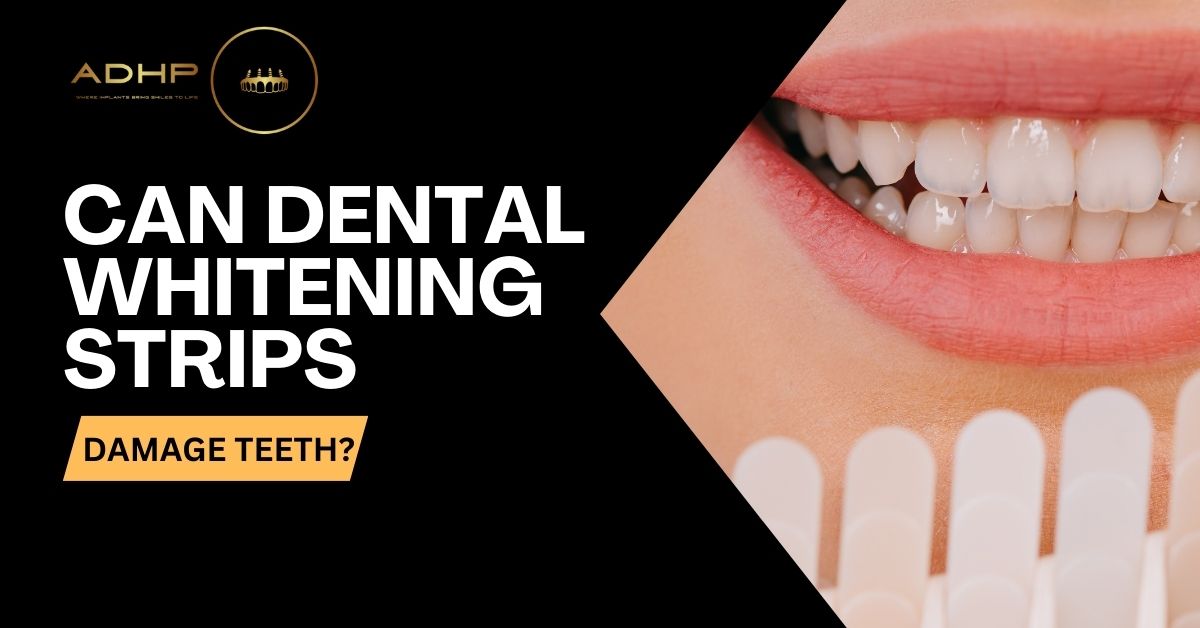Main Takeaways:
- Whitening strips work by using peroxide to break down stains on tooth enamel, making teeth appear whiter.
- Overuse or incorrect use can lead to sensitivity, gum irritation, enamel erosion, and uneven whitening.
- Watch for warning signs like lingering sensitivity, gum pain, sharp toothaches, or enamel changes—stop use and see a dentist if they occur.
- Avoid use if you have sensitive teeth, gum disease, cavities, dental work, or are pregnant/nursing—always check with your dentist first.
- Safer whitening options include professional treatments, whitening toothpaste/mouthwash, and lifestyle changes to prevent stains.
- See your dentist first to check for dental issues and get personalized, safe whitening recommendations.
- Maintain your results with good oral hygiene, a stain-conscious diet, and occasional touch-ups as needed.
Everyone wants a bright, sparkling smile. It makes you feel good and can boost your confidence. With so many products promising whiter teeth, whitening strips are a popular choice. They’re easy to use and seem to offer quick results right at home. But if you’re thinking about trying them, a big question might pop into your head: can whitening strips damage teeth? Let’s dig into that and figure out how to get a brighter smile safely.
How Whitening Strips Work (The Basics)
Before we talk about damage, it helps to know what whitening strips actually do. Most whitening strips have a thin layer of gel on them. This gel contains special ingredients, usually hydrogen peroxide or carbamide peroxide. These are the same kinds of ingredients dentists use for professional whitening, just in lower amounts.
When you stick the strip to your teeth, the peroxide gel sits against your tooth enamel. Enamel is the hard, outer layer of your teeth. Over time, things like coffee, tea, red wine, and certain foods can stain this enamel, making your teeth look dull or yellow. The peroxide in the strips works like a tiny bleach. It gets into the enamel and breaks down the molecules that cause stains, making them less visible. This makes your teeth appear whiter.
The strips are designed to be thin and flexible, so they fit snugly on your teeth. You usually wear them for a certain amount of time each day, as directed by the package, for a set number of days or weeks. It sounds simple, but understanding this process is key to figuring out, can whitening strips damage teeth?
The Big Question: Can Whitening Strips Damage Teeth?
So, back to our main question: can whitening strips damage teeth? The short answer is, it’s possible, especially if you don’t use them correctly. While most people use them without major issues, there are some risks to be aware of.
The main concerns usually come from the peroxide in the strips. While it’s great at breaking down stains, it’s also a powerful chemical.
- Tooth Sensitivity: This is the most common side effect. You might feel a tingly or sharp pain in your teeth, especially when eating or drinking something hot or cold. This happens because the peroxide can temporarily make tiny tubes in your tooth enamel more open, exposing the sensitive inner part of your tooth. For most people, this sensitivity is temporary and goes away after they stop using the strips. But for some, it can be quite uncomfortable.
- Gum Irritation: Sometimes, the whitening gel can get onto your gums. Because gums are softer than teeth, the peroxide can irritate them, making them look white or inflamed. This is usually temporary, but it can be painful and might be a sign you’re not applying the strips correctly or that they’re too strong for your gums.
- Enamel Erosion (Rare but Serious): This is a more serious concern, though it’s less common with proper use. If you use whitening strips too often, for too long, or if the product is too strong, there’s a small risk that the peroxide could start to wear away your tooth enamel. Enamel does not grow back. Once it’s gone, it’s gone. Thinning enamel can lead to permanent sensitivity, make your teeth look more yellow (because the darker layer underneath shows through), and increase your risk of cavities.
- Uneven Whitening: Strips are flat, and teeth aren’t. They might not cover every curve or gap on your teeth perfectly. This can lead to a splotchy or uneven white appearance. Also, if you have dental work like fillings, crowns, or veneers, whitening strips won’t change their color. This means your natural teeth might get whiter, but your dental work will stay the same shade, leading to a noticeable mismatch.
So, while whitening strips are generally considered safe for most people when used as directed, ignoring the instructions or overdoing it definitely increases the chance of problems. This is why knowing the answer to can whitening strips damage teeth is so important before you start.
Signs of Trouble: When Whitening Strips Might Be Harming Your Teeth
It’s helpful to know what signs to watch for if you’re worried about can whitening strips damage teeth. If you notice any of these, it’s a good idea to stop using the strips and talk to your dentist.
- Increased or Lingering Sensitivity: If your teeth become very sensitive to hot or cold, or if the sensitivity doesn’t go away after a day or two of not using the strips, that’s a warning sign.
- Gum Pain or Whitening: If your gums start to hurt, look irritated, or turn white where the strip has touched them, it means the peroxide is irritating your gum tissue.
- Sharp, Shooting Pains: While some dull sensitivity is common, sharp, sudden pains (especially when breathing in cold air or drinking) could signal more irritation to the tooth nerve.
- Changes in Enamel Texture: If your teeth feel rough, chalky, or look dull even after rinsing, it might be a sign of enamel changes.
- Dark Spots or Translucency: In very rare cases, if enamel is severely eroded, teeth might look more transparent at the edges, or underlying darker dentin might show through in spots.
- Existing Dental Issues Getting Worse: If you had a small crack, a sensitive spot, or a filling that felt fine before, and it suddenly feels worse after using the strips, something might be off.
Remember, your teeth are unique, and what affects one person might not affect another. Listening to your body and noticing any changes are crucial when using whitening products. Don’t just push through pain, especially if you’re concerned about can whitening strips damage teeth.
Who Should Be Extra Careful (Or Avoid Them Entirely)
While many people use whitening strips, certain groups should be extra cautious or avoid them completely. This is key to understanding can whitening strips damage teeth in specific situations.
- People with Sensitive Teeth Already: If your teeth are already sensitive to hot or cold, whitening strips will likely make that worse. It’s better to talk to your dentist first.
- Anyone with Gum Disease: If you have gingivitis (gum inflammation) or more serious gum disease (periodontitis), the peroxide can irritate your gums further, making the condition worse or more painful.
- People with Cavities, Cracks, or Exposed Roots: If you have untreated cavities, cracks in your teeth, or areas where your gum has receded and exposed the tooth root, the peroxide can get directly to the sensitive inner layers of your tooth. This can cause extreme pain and potentially damage the tooth. Always get dental issues fixed before whitening.
- Pregnant or Breastfeeding Individuals: Most dental professionals recommend avoiding teeth whitening during pregnancy and breastfeeding, as the effects of the peroxide on the developing baby are not fully known. It’s best to err on the side of caution.
- Children and Teenagers: The enamel on young teeth is thinner and more porous, and the pulp (the living tissue inside the tooth) is larger. Whitening products can cause more significant sensitivity and potential damage to developing teeth. It’s generally advised to wait until at least age 16, or better yet, until adulthood.
- Those with Existing Dental Work: As mentioned, fillings, crowns, veneers, and bonding do not whiten. If you have a lot of these, whitening your natural teeth will create an uneven smile, which you likely won’t be happy with.
- People with Specific Health Conditions: Certain health issues or medications can affect oral health and make whitening risky. Always talk to your dentist if you have any underlying health concerns.
Always consult your dentist before starting any at-home whitening regimen. They can assess your oral health and tell you if whitening strips are a safe option for you, helping to answer your personal question of can whitening strips damage teeth.

Safer Ways to Whiten Your Teeth
If you’re worried about the question, can whitening strips damage teeth, or if they’re not right for you, there are other ways to get a brighter smile.
- Professional Dental Whitening: This is often the safest and most effective option. Your dentist uses stronger whitening agents, but they can control the process carefully. They protect your gums and can adjust the treatment to your sensitivity level. This might include in-office treatments (often using light or laser activation) or custom-made trays you use at home with a stronger gel than strips. While more expensive, the results are usually more dramatic and even, and done under professional supervision.
- Whitening Toothpastes: These toothpastes contain mild abrasives or chemicals that help remove surface stains. They don’t change the actual color of your teeth, but they can make them look brighter by cleaning off stains. They are generally very safe for daily use.
- Whitening Mouthwashes: Similar to toothpastes, these contain small amounts of whitening agents and help remove surface stains over time. They are a gentle option, but results are usually subtle.
- Good Oral Hygiene: This is the foundation of a healthy, naturally brighter smile. Brushing twice a day with a fluoride toothpaste, flossing daily, and having regular dental cleanings remove plaque and surface stains. A healthy mouth often looks brighter naturally.
- Dietary Changes: Limiting foods and drinks that cause stains (like coffee, tea, red wine, dark sodas, berries) can help prevent new stains from forming. If you do consume them, try to rinse your mouth with water afterward.
Your dentist can discuss all these options with you, explain the pros and cons, and help you choose the best and safest path to a brighter smile. They are your best resource for personalized advice, especially if you’re concerned about can whitening strips damage teeth.
The Role of Your Dentist Before Whitening
Before you even think about buying whitening strips or any other whitening product, a visit to your dentist is truly the most important step. They can fully answer your question, can whitening strips damage teeth, in your specific situation.
- Oral Health Check-up: Your dentist will give you a thorough check-up. They’ll look for cavities, gum disease, cracks, or any other dental problems. If you have any of these issues, whitening products could cause pain or make the problem worse. Fixing these first is crucial for safe whitening.
- Identifying Stain Causes: Your dentist can help figure out why your teeth are discolored. Sometimes, discoloration isn’t just from surface stains; it could be from certain medications, an injury to a tooth, or even just genetics. Whitening strips only work on certain types of stains, so knowing the cause helps choose the right treatment.
- Assessing Sensitivity: If you already have sensitive teeth, your dentist can suggest ways to manage it before or during whitening, or recommend alternative, gentler whitening methods.
- Existing Dental Work Check: Your dentist will tell you if any existing fillings, crowns, or veneers will be affected. As mentioned, these won’t whiten, so understanding this beforehand prevents disappointment and an uneven smile.
- Professional Guidance: They can recommend the safest and most effective whitening options for you, whether it’s specific over-the-counter products, custom trays, or in-office treatments. They can also explain the proper way to use products to minimize risks.
Think of your dentist as your smile expert. Getting their advice before starting any whitening journey is the best way to ensure it’s safe and gives you the results you want.
The Science Behind Whitening
To fully grasp the answer to can whitening strips damage teeth, it’s helpful to understand a bit more about how whitening works at a microscopic level.
Your tooth enamel isn’t a perfectly smooth, solid surface. It’s made up of tiny mineral rods with microscopic pores or openings. Over time, staining molecules from food, drinks, and even tobacco can get trapped in these pores, changing the color of your teeth.
The peroxide in whitening strips works by breaking down these staining molecules. It penetrates the enamel and breaks apart the chemical bonds of the chromogens (the colored compounds) that cause stains. This process is called oxidation. When the chromogens are broken down, they become colorless or less concentrated, making your teeth appear lighter.
The reason you feel sensitivity is often because the peroxide also temporarily opens up these tiny pores in the enamel more widely. This can expose the dentin layer underneath, which contains microscopic tubes leading to the nerve in the center of your tooth. When these tubes are exposed, hot, cold, or even air can stimulate the nerve, causing sensitivity. This is usually temporary and reversible once you stop using the whitening product.
However, repeated or excessive exposure to high concentrations of peroxide, especially without proper dental supervision, could theoretically lead to more significant changes in the enamel’s structure over a very long period, or if the enamel was already compromised. This is why following instructions and consulting a dentist are so important. The goal is to break down stains without causing harm to the tooth’s structure.
Maintaining Your Whitened Smile
Once you’ve achieved that brighter smile, the next step is to keep it that way. This isn’t about whether can whitening strips damage teeth, but how to make your efforts last without needing constant re-whitening.
- Excellent Oral Hygiene: This is always number one. Brush your teeth twice a day for two minutes with a fluoride toothpaste. Floss daily to remove plaque and food particles that can lead to stains. Regular dental check-ups and professional cleanings are also key to removing surface stains before they become set.
- Watch What You Eat and Drink: Certain foods and beverages are notorious for staining teeth. Coffee, tea, red wine, dark sodas, berries (like blueberries and blackberries), and dark sauces (like soy sauce or balsamic vinegar) are common culprits. You don’t have to cut them out completely, but try to limit them.
- Rinse After Staining Foods: If you do consume staining foods or drinks, rinse your mouth with water immediately afterward. This helps wash away some of the staining particles before they can settle into your enamel.
- Use a Straw: For cold drinks like soda, iced tea, or iced coffee, using a straw can help the liquid bypass your front teeth, reducing direct contact with staining agents.
- Avoid Tobacco Products: Smoking and chewing tobacco are major causes of tooth discoloration. Quitting tobacco is one of the most effective ways to keep your teeth white and improve your overall oral and general health.
- Touch-Up Treatments (Sparingly): If you notice your teeth starting to dull over time, you can do touch-up whitening treatments. However, don’t overdo it. Follow your dentist’s recommendations or the product instructions carefully. Less is often more to avoid potential sensitivity or damage.
Consistency in your daily habits is far more important than frequent harsh whitening. By focusing on good oral care and being mindful of your diet, you can maintain your beautiful, bright smile for longer.

A Bright Smile, Safely Achieved with ADHP – Fallbrook
Having a bright smile is wonderful, and whitening strips offer an accessible way to achieve it. But the question can whitening strips damage teeth is a valid one that deserves a thoughtful answer. While generally safe when used correctly, improper use can lead to sensitivity, gum irritation, and, in rare cases, more serious enamel issues.
The best way to get a safely brighter smile is to first talk to your dentist. They can assess your unique oral health, discuss your options, and guide you toward the best and safest path for you. Whether it’s through professional whitening, careful use of at-home products, or simply maintaining excellent oral hygiene, a healthy, dazzling smile is within reach.
If you’re dreaming of a brighter smile and want to know more about safe whitening options, or if you’re worried about can whitening strips damage teeth for your specific needs, it’s time to consult with dental professionals. For personalized advice and comprehensive dental care in Fallbrook, contact ADHP – Fallbrook today. Their team is dedicated to helping you achieve a healthy, confident smile safely.





